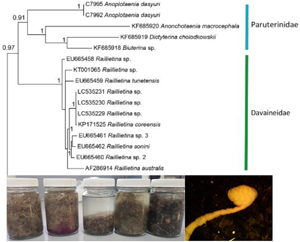Published online by Cambridge University Press: 18 August 2021

Anoplotaenia dasyuri Beddard, 1911 (Cestoda), from the Tasmanian devil, Sarcophilus harrisii (Boitard, 1842), is a taxonomic enigma, where a combination of morphological features, host type and geographical location have prevented it from being placed within a family and it is considered incertae sedis, despite its accepted validity. We performed a phylogenetic analysis of three A. dasyuri specimens collected from three Tasmanian devils using 18S and 28S rRNA sequences. Anoplotaenia dasyuri was found to have closest affinity with the family Paruterinidae, especially the genus Cladotaenia Cohn, 1901. The postulated theory of transfer of an ancestor of Anoplotaenia Beddard, 1911 transferring to the Tasmanian devil from an unrelated carnivorous host, such as an accipitriform or other carnivorous bird, is discussed and supported.